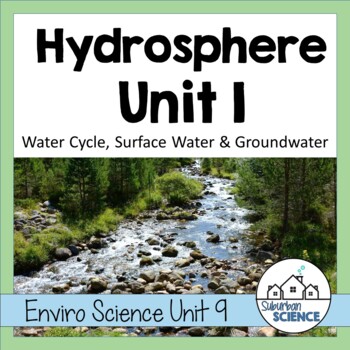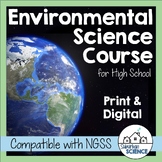Environmental Science Unit: Surface Water, Groundwater, & the Water Cycle
- Zip
What educators are saying
Also included in
- This bundle contains 6 weeks' worth of lessons, labs, and field activities to introduce your high school students to aquatic ecosystems, surface water, groundwater, marine biomes, and water pollution. Choices are integrated into the unit to provide options for teaching and learning in a variety ofPrice $55.00Original Price $65.00Save $10.00
- These environmental lesson plans will help your students to take charge of their learning! This comprehensive course is interactive, hands-on, and student-centered! Students learn about major environmental issues in modern society through detailed lessons and activities. Units cover the four sphePrice $250.00Original Price $276.00Save $26.00
Description
This comprehensive set of lessons and activities will introduce your students to the topics of surface water, groundwater, and the water cycle. Human impacts on the environment are interwoven through each lesson to provide students with a good basis for any environmental science or APES course. A PowerPoint, guided notes, web-quests, doodle notes, activities, extension pages, and assessments are all included in this lesson. All student pages come in both PRINT and DIGITAL versions for efficient use in class or through distance learning.
➤PLEASE NOTE: This unit is also included in my FULL ENVIRONMENTAL SCIENCE CURRICULUM.
➤What's included?
-10 Teacher Planning Pages (standards document, editable daily pacing guide, differentiation ideas for student interest, ability, and learning environment)
-1 PowerPoint (28 editable slides- highly visual and fully animated)
-3 pages of Cornell Notes (both fill-in-the-blank and editable versions included)
-3 web-quests with corresponding student pages for independent learning
-3 pages of my popular Doodle Notes(TM) and a guide to using them in your classroom
-7 Activities:
- Properties of Water Stations Lab
- Macroinvertebrate Stream Study (includes presentation for pre-lab)
- Personal Water Audit
- Watershed Mapping Activity
- Building an Aquifer STEM Model
- Irrigation Jigsaw Group Research Activity
- Salination Investigation Lab
-10 Extension Pages:
- 4 Digging Deeper extensions for critical thinking: Acid Rain, Dams, Riparian Zones, The Ogallala Aquifer
- 5 Data Analysis extensions to practice on interpretation of graphs & math integration: Effects of Deforestation, Eutrophication, Irrigation, Impacts of Irrigation, Well Lift Costs
- 1 Case Study: The Controversial Mesquite Tree
-1 quiz through Google Forms for automatic online grading
-24 editable task cards for a quick and easy unit review
-Editable unit test with multiple-choice and short answer questions (in both honors and regular versions)
-Supplementary Resource Ideas: links and videos for additional explanation or exploration
-Answer keys and grading rubrics for all student pages
➤What topics are included in this unit?
Introduction to Water & The Hydrologic Cycle
- Unique properties of water
- Cohesion v. adhesion
- Processes in the water cycle (transpiration, condensation, evaporation, etc.)
- Acid rain
- Effects of deforestation on the water cycle
Surface Water & Watersheds
- Watersheds (tributaries, divides, etc.)
- Headwaters v. flat river
- Estuaries
- Eutrophication and acidification of aquatic ecosystems
- Macroinvertebrate identification
- Structure and impact of dams
- Benefits of riparian buffers
Groundwater & Irrigation
- Water table
- Aquifers (confined v. unconfined)
- Tragedy of the Commons
- Types of irrigation (flood, furrow, spray, drip)
- Human impacts from groundwater usage (depletion of aquifers, salinization, etc)
The unit is aligned to NGSS and many state standards. If you’d like to know whether your state standards are covered, you can send me an email at support@suburbanscience.com.
NGSS addressed in this unit: HS-ESS2-2, HS-ESS2-5, HS-ESS3-1, HS-ESS3-2, HS-ESS3-3, HS-ESS3-4, HS-ESS3-5, HS-ESS3-6, HS-LS2-6, HS-LS2-7, HS-LS4-6, HS-ETS1-3 . Additional details on standards are included in the teacher planning pages of this course.
_________________________________________________________________ _______
*For more details about the specific topics and items included, please see my PREVIEW.*
➤Where can I find other Environmental Science lessons?
Intro to Environmental Science
Biosphere Unit 1: Ecology, Food webs, and Symbiosis
Biosphere Unit 2: Species and Population Ecology
Biosphere Unit 3: World Biomes, Ecological Succession, and Biodiversity
Atmosphere: Weather, Wind, and Biogeochemical Cycles
Geosphere Unit 1: Plate Tectonics and Landforms
Geosphere Unit 2: Minerals, Mining, and Soil
Geosphere Unit 3: Fossil Fuels and Renewable Energy
Hydrosphere Unit 1: Surface Water, Groundwater, and the Water Cycle
Hydrosphere Unit 2: Marine Biomes and Water Pollution
Or get the Full Environmental Science Curriculum which includes all these units!
➤What curriculum could I use with this lesson?
This lesson is ideally geared toward high school students and would work well with a general-level Environmental Science or Biology textbook. It addresses the following topics in AP Environmental Science (APES):
- 1.7: The Hydrologic Cycle
- 4.6: Watersheds
- 5.1: The Tragedy of the Commons
- 5.2: Clearcutting
- 5.4: Impacts of Agricultural Practices
- 5.5: Irrigation Methods
- 5.10: Impacts of Urbanization
- 5.11: Ecological Footprints
- 5.12: Introduction to Sustainability
- 7.7 Acid Rain
- 8.2: Human Impacts on Ecosystems
- 8.5: Eutrophication
➤Can I edit these resources to fit my needs?
Some of the files in this unit are editable. The text on the PowerPoints, Cornell Notes, and task cards is all editable so you can adjust the level of content and wording. The pacing guide, printable unit tests, and online quizzes through Google Forms™ are all fully editable. Web-quests, activities, extension pages, and any images included in this unit are in non-editable PDF formats to protect my intellectual property rights and those of the illustrators whose images I’ve purchased for use in this resource.
________________________________________________________________________
⭐For updates about sales and new products, please follow my store: My TpT Store
You can also
⭐Subscribe to my newsletter for freebies and teaching tips
⭐Follow me on Instagram
⭐Check out my Facebook page
⭐Follow me on Pinterest
I value your feedback. Please rate this product. If you have any issues or questions about this product, please feel free to ask a question in my store or write to me at support@suburbanscience.com.







